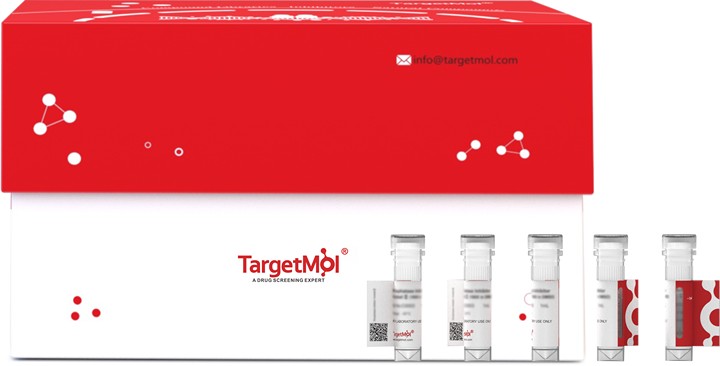 Your shopping cart is currently empty
Your shopping cart is currently empty
MANSC1 Protein, Mouse, Recombinant (His)
Catalog No. TMPK-01155
MANSC1 contains 1 MANSC domain. MANSC is a seven-cysteine-containing domain present in animal membrane and extracellular proteins. MANSC (motif at N terminus with seven cysteines) is a novel domain with a well-conserved seven-cysteine motif that is present at the N terminus of membrane and extracellular proteins, including low-density lipoprotein receptor-related protein 11 (LRP-11), hepatocyte growth factor activator inhibitor 1 (HAI-1) and some uncharacterized proteins encoded by multicellular animals from Mollusca to Chordata. The MANSC domain in HAI-2 might function through binding with hepatocyte growth factor activator and matriptase[1].

MANSC1 Protein, Mouse, Recombinant (His)
Catalog No. TMPK-01155
MANSC1 contains 1 MANSC domain. MANSC is a seven-cysteine-containing domain present in animal membrane and extracellular proteins. MANSC (motif at N terminus with seven cysteines) is a novel domain with a well-conserved seven-cysteine motif that is present at the N terminus of membrane and extracellular proteins, including low-density lipoprotein receptor-related protein 11 (LRP-11), hepatocyte growth factor activator inhibitor 1 (HAI-1) and some uncharacterized proteins encoded by multicellular animals from Mollusca to Chordata. The MANSC domain in HAI-2 might function through binding with hepatocyte growth factor activator and matriptase[1].
| Pack Size | Price | USA Warehouse | Global Warehouse | Quantity |
|---|---|---|---|---|
| 5 μg | $51 | 7-10 days | 7-10 days | |
| 10 μg | $80 | 7-10 days | 7-10 days | |
| 20 μg | $129 | 7-10 days | 7-10 days | |
| 50 μg | $248 | 7-10 days | 7-10 days | |
| 100 μg | $418 | 7-10 days | 7-10 days | |
| 200 μg | $757 | 7-10 days | 7-10 days | |
| 500 μg | $1,670 | 7-10 days | 7-10 days |
Add to Cart
Add to Quotation
In Stock Estimated shipping dateUSA Warehouse [1-2 days] Global Warehouse [5-7 days]
All TargetMol products are for research purposes only and cannot be used for human consumption. We do not provide products or services to individuals. Please comply with the intended use and do not use TargetMol products for any other purpose.
Resource Download
Product Information
| Biological Activity | Activity has not been tested. It is theoretically active, but we cannot guarantee it. If you require protein activity, we recommend choosing the eukaryotic expression version first. |
| Description | MANSC1 contains 1 MANSC domain. MANSC is a seven-cysteine-containing domain present in animal membrane and extracellular proteins. MANSC (motif at N terminus with seven cysteines) is a novel domain with a well-conserved seven-cysteine motif that is present at the N terminus of membrane and extracellular proteins, including low-density lipoprotein receptor-related protein 11 (LRP-11), hepatocyte growth factor activator inhibitor 1 (HAI-1) and some uncharacterized proteins encoded by multicellular animals from Mollusca to Chordata. The MANSC domain in HAI-2 might function through binding with hepatocyte growth factor activator and matriptase[1]. |
| Species | Mouse |
| Expression System | HEK293 Cells |
| Tag | C-His |
| Accession Number | Q9CR33 |
| Synonyms | MANSC1,LOH12CR3,9130403P13Rik |
| Construction | Gly25-Leu369 |
| Protein Purity | > 95% as determined by Tris-Bis PAGE; > 95% as determined by HPLC |
| Molecular Weight | 38.2 kDa (predicted). Due to glycosylation, the protein migrates to 58-110 kDa based on Tris-Bis PAGE result. |
| Endotoxin | < 1 EU/μg by the LAL method. |
| Formulation | Lyophilized from a solution filtered through a 0.22 μm filter, containing PBS (pH 7.4). Typically, 8% trehalose is incorporated as a protective agent before lyophilization. |
| Reconstitution | Reconstitute the lyophilized protein in distilled water. The product concentration should not be less than 100 μg/ml. Before opening, centrifuge the tube to collect powder at the bottom. After adding the reconstitution buffer, avoid vortexing or pipetting for mixing. |
| Stability & Storage | It is recommended to store recombinant proteins at -20°C to -80°C for future use. Lyophilized powders can be stably stored for over 12 months, while liquid products can be stored for 6-12 months at -80°C. For reconstituted protein solutions, the solution can be stored at -20°C to -80°C for at least 3 months. Please avoid multiple freeze-thaw cycles and store products in aliquots. |
| Shipping | In general, Lyophilized powders are shipping with blue ice. |
| Research Background | MANSC1 contains 1 MANSC domain. MANSC is a seven-cysteine-containing domain present in animal membrane and extracellular proteins. MANSC (motif at N terminus with seven cysteines) is a novel domain with a well-conserved seven-cysteine motif that is present at the N terminus of membrane and extracellular proteins, including low-density lipoprotein receptor-related protein 11 (LRP-11), hepatocyte growth factor activator inhibitor 1 (HAI-1) and some uncharacterized proteins encoded by multicellular animals from Mollusca to Chordata. The MANSC domain in HAI-2 might function through binding with hepatocyte growth factor activator and matriptase[1]. |
Dose Conversion
You can also refer to dose conversion for different animals. More
Calculator
Tech Support
Please read the User Guide of Recombinant Proteins for more specific information.
Generate Quote
Catalog No.: Cas No.:
Add
| Size | Quantity | Unit Price | Amount | Operation |
|---|
Generate Quote

Copyright © 2015-2025 TargetMol Chemicals Inc. All Rights Reserved.



